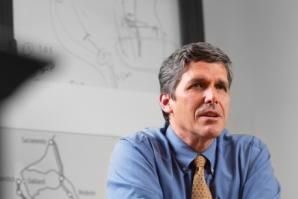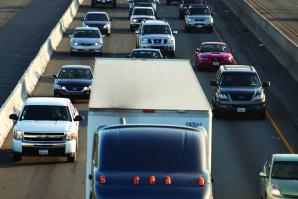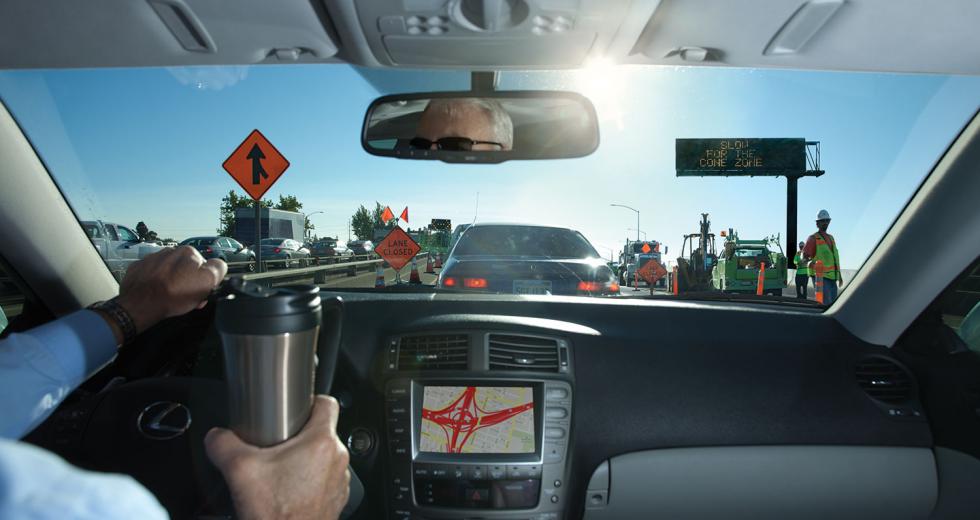There are roads that the director of San Joaquin County’s transportation-planning agency forbids his teenage daughter from driving on. Andrew Chesley wants the girl to avoid the off-ramps along Highway 99 that allow precious few seconds to decelerate from 65 to 15 mph. Vehicles that don’t brake fast enough on these so-called hook ramps risk hurling into oncoming traffic.
Despite his concern, Chesley fears his daughter drives there anyway.
“She’s 16 years old,” says Chesley, the executive director of the San Joaquin Council of Governments. “She rolls her eyes and says, ‘Dad, I know what I’m doing.’ But on (Interstate) 5, a friend of mine’s daughter was just in an accident. She had scratches on her face and arms, and the car was totaled. My daughter has taken this a little more to heart because of that.”
Chesley is overseeing a Highway 99 expansion project to remove six hook ramps on a stretch through Stockton. Plans are also underway to repair concrete panels on a nearby stretch of I-5 that have warped due to moisture.
The cracked panels protrude above the road, rattling the steering wheels of passing cars. When untreated, the concrete tilts higher above ground and can knock car tires out of alignment and overturn motorcycles. Eventually, the panels can get so waterlogged that the freeway begins to cave in — a serious safety hazard with exorbitant repair costs, Chesley says.
Although San Joaquin residents have twice agreed to increase sales taxes to support the roads, the council can only keep up with about 50 percent of the needed repairs, and Chesley is not optimistic about future funding. Stockton carries the unfortunate distinction of having some of the worst sections of I-5 and Highway 99 in California. But some fear the cities’ crumbling infrastructure could present a future snapshot of the entire state.
Between the 1950s and early 1970s, California embarked on massive transportation projects to connect growing lines of people and economies. But as highway traffic doubled over the succeeding three decades, roadway spending fell out of pace. Today, as the Golden State’s once-monumental highway system nears the end of its service life, politicians and the press have largely focused on controversial plans to build a bullet train, an ambitious project observers fear could drain funding away from the existing infrastructure.
Without high-speed rail, the California Transportation Commission projects the state will need to spend about $540 billion on roads through 2020 — about 60 percent for repairs and the rest for management and expansion. Funding is expected to fall about $300 billion short.
“Once those (previously approved) projects are completed, the transportation funding picture looks really bleak. Unless something magically appears, there really is not a reliable and a stable source of funding,” says Bimla Rhinehart, executive director of the CTC, which allocates transportation funds throughout California.
That’s not to say the public hasn’t tried to support its investment. In 2006 voters approved a statewide bond measure that brought in nearly $11 billion for transportation projects. The federal stimulus dollars also helped, and in June, Congress approved a $105 billion federal highway-spending bill.
But experts note that transportation spending has fallen as a funding priority on all levels of government. Gas tax revenues also have fallen because of inflation and proliferation of fuel-efficient cars. Existing funding often is swept toward politically appealing road expansion projects that boast of new achievement through the pageantry of ribbon cutting.
“We are good about building new roads, what we don’t include is life-cycle cost,” Rhinehart says. “We put new bridges in, but we don’t have the cost to maintain the system. That’s why we keep getting further and further behind.”
California highways ranked 48th in the nation in state highway performance and cost-effectiveness, according to the 2010 Annual Highway Report by the Reason Foundation, a libertarian Los Angeles-based think tank. The state ranked worst in the nation for urban interstate congestion and 49th for both urban and rural interstate condition.
Amador County has some of the worst streets and road conditions in the Capital Region. The county scores 34 out of 100 on the “Pavement Condition Index,” according to a 2011 report by Nichols Consulting Engineers of Richmond, a firm that helps local governments plan infrastructure projects. Placer County has some of the region’s best roads, with a PCI of 77. The PCI of Sacramento County is 66. Local officials worry that these conditions detract from the region’s livability.
“It does affect quality of life in some areas,” says Mike Penrose, director of Sacramento County’s Department of Transportation. “I don’t think (people) are going into depression, but they are driving in and out of a crappy road to get to their job every day, and they are saying, ‘This is very undesirable.’”
Bad conditions also cause motorists to avoid certain roadways, which places additional strain on infrastructure because suddenly a road that was never intended as a major passageway endures a high volume of traffic and begins to deteriorate, Penrose says. Over the next decade, Penrose predicts more traffic in the Capital Region, longer commutes and lousier road conditions.
As for solutions, there is an argument for directing more money toward road improvement and away from alternative transportation programs such as trains, buses and bicycles. There were about 1 million workers in the Sacramento region in 2008, the latest year that data is available from the Sacramento Area Council of Governments (SACOG). About 2.6 percent of those workers commuted via public transit, and 3.6 percent walked or biked for their commute.
Yet transit takes up 32 percent of total public transportation spending, and biking and pedestrian projects take up 8 percent.
Representatives from TransForm, a Bay Area-based alternative transportation advocacy group, assert that SACOG’s figures are more of a proposed projection for future allocations that don’t represent actual spending, which is tilted toward expansion projects instead of more sustainable options.
The government has “been spending money on roads for decades. That’s why you have no viable choice other than driving. That’s why people are getting angry,” says Graham Brownstein, TransForm’s state policy director. “The only way to actually stop this downward spiral and stop digging our hole deeper is to dramatically increase the amount we are spending on these alternative modes so people aren’t stuck in their cars.”
“We are good about building new roads, what we don’t include is life-cycle cost. …we don’t have the cost to maintain the system.”
Bimla Rhinehart, executive director, California Transportation Commission
Brownstein, who drives a Subaru but says he takes public transit every chance he gets, adds that government officials and advocates across the state should develop a long-term transportation-spending plan that largely places a moratorium on new roads. Though he’s optimistic about the alliance being built between interest groups that have historically disagreed, Brownstein hasn’t convinced everyone. Adrian Moore, vice president of research at the Reason Foundation, wonders how much funding bus and bike advocates believe they deserve.
“Seventy five percent of the money? All of the money? Sure, if we
just quit spending on the roads and closed the roads down, then
everyone would have to ride transit,” he says. “I’m sure that
would be a popular option. That logic doesn’t go anywhere. No
matter what we do, people want to drive.”
Moore also proposes savings from cutting administration costs. Using data from the Federal Highway Administration, Reason found California has the worst administrative disbursements per mile, meaning that the state’s Department of Transportation takes the highest overhead of any state transportation agency.
“We’re using twice as many people per lane mile as Texas — that means we’re just bad on personnel,” says Moore, who was appointed in 2009 to the state Public Infrastructure Advisory Commission, a group arranged under former Gov. Arnold Schwarzenegger to develop public-private infrastructure financing agreements. The commission has languished under the Brown administration, says Moore.
In response, Caltrans officials wrote in an email that the Reason Foundation used inadequate data to draw conclusions about inefficient spending.
One potential funding source under consideration is a new system that charges motorists for the extent they use the roadways. This could be accomplished if the government tracked oil changes or other routine maintenance or travel habits by monitoring the global positioning systems on driver’s cell phones. But officials acknowledge that new forms of government tracking could arouse privacy concerns.
One remaining option is to raise funds within the existing payment structure. After the upcoming November election, government officials plan to ramp up a lobbying campaign to bring more public awareness and eventually dollars to state infrastructure needs. But the simultaneous push for high-speed rail is expected to be a hurdle. While many transportation officials also support the bullet train, they recognize the inevitable funding tradeoff posed by a giant new state investment.
“It’s a balancing act — high-speed rail or improving the existing system we have. It would be great if we had the revenue sources to have a world-class transportation system in California. Both need it,” says Rhinehart. “It’s going to be a difficult decision for the voters.”
Recommended For You

The Conductor
The California High-Speed Rail Authority replaced an engineer with a political operative to lead the nation’s biggest public works project. Jeff Morales instantly charmed his opponents but made technical decisions that placed high-speed rail at the mercy of the courts. Can Morales save his runaway train?

Every Road Has Its Thorns
Transportation funding slows Placer projects
When the president announced his federal stimulus plan, jurisdictions across the nation crossed their fingers for funding, and Placer County got in line.



